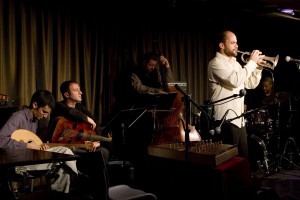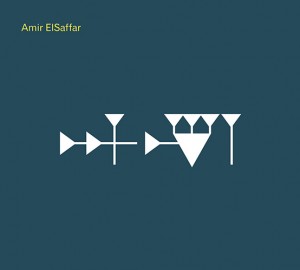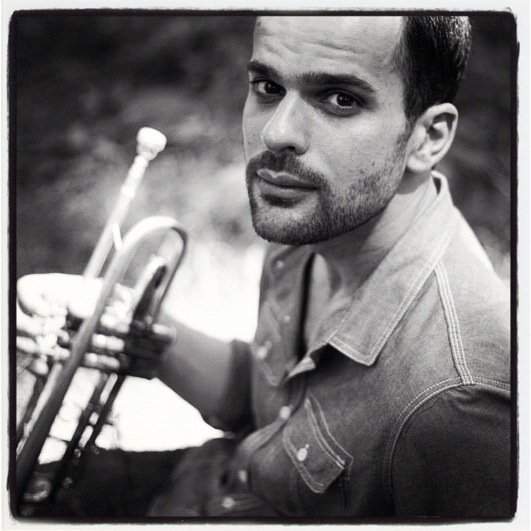BY ZIVIT SHLANK In Arabic, an ‘amir’ is a commander or chieftain, in other words a person who leads with authority. Trumpeter, composer and singer Amir ElSaffar lives up to his namesake. Born into an Iraqi-American family, his parents and sisters encouraged a love of music early on. He’s had a love-loathe relationship with the trumpet since age nine, intrigued by its power and potential, but discouraged by forced lessons and initial limitations. Despite that, Amir immersed himself in the intimate study of both classical and jazz trumpet and he was drawn to the emotional honesty of jazz. Couple that with a naturally curious and rebellious nature, at the urging of saxophonist and mentor Rudresh Mahanthappa, he moved to New York as a post-collegiate to pursue his passion. However, that wasn’t enough for Amir. His growing intrigue with Arabic maqam — the unique melodic scale used in traditional Arabic music — simply could not be ignored. He journeyed to Iraq in 2002 to study maqam, came back the states a few years later armed with a new musical perspective which has since been met with great success. His latest CD entitled Inana, a continuation of his Two Rivers that acts not so much as a juxtaposition, so much as a deeper and sincere confluence of seemingly contradictory elements. America and Iraq, Maqam and Jazz, Masculine and Feminine, there are commonalities betwixt these worlds that bind us together. The musical vocabulary of the ancient and the modern are intertwined seamlessly. The results are so sensual, so engaging, it demystifies all doubt and further confirms the globally unifying power of jazz and its infinite possibilities. Amir, armed with his music and his ensemble, is considered by many a commandeer of this movement. Once again, we have the mad hatters of Ars Nova Workshop to thank for bringing ElSaffar and his Two Rivers Ensemble to Philadelphia tonight for a rare appearance at the Philadelphia Art Alliance.
PHAWKER: What was your first musical memory?
AMIR ELSAFFAR: The only musicians in my family are of my generation, my sister as well as my half sister. My father unwittingly, he didn’t mean for us to become musicians, played me a lot of music when I was a little kid including Louis Armstrong recordings. I think that was the first thing I remember ever hearing was Louis Armstrong and Ella Fitzgerald singing Porgy and Bess. That’s definitely my first musical memory.
PHAWKER: Was Louis responsible for encouraging you to pursue the trumpet?
AMIR ELSAFFAR: Not exactly. I started playing trumpet when I was 9 years old as part of the band program in school. Actually I didn’t even want to play trumpet, I wanted to play saxophone. However, I couldn’t get a sound out of the saxophone, but could get one out of the trumpet. That put enough of an impression on the band director and he thought ‘maybe it’d be less work for this guy on the trumpet’, so they kinda steered me in that direction. My mother made me stick with trumpet lessons, which I just dreaded. I wasn’t really interested. High School, I was playing guitar concurrently, and I was into blues and  rock music. I always felt like the guitar was a fun instrument to play because there was so much great music associated with it, while the trumpet I just associated with school and concert band, always a thing I had to do. It was a progression that started with The Beatles, The Rolling Stones, then the late 60s rock and pop music, listening to a lot of Jimi Hendrix and trying to imitate that on the guitar.
rock music. I always felt like the guitar was a fun instrument to play because there was so much great music associated with it, while the trumpet I just associated with school and concert band, always a thing I had to do. It was a progression that started with The Beatles, The Rolling Stones, then the late 60s rock and pop music, listening to a lot of Jimi Hendrix and trying to imitate that on the guitar.
PHAWKER: So who or what got you to love the trumpet?
AMIR ELSAFFAR: What first got me really excited about the trumpet was classical music. When I was in 8th grade I heard the Haydn Trumpet Concerto, which was the first piece written that sort of resembles the modern trumpet sound. I remember hearing it and thinking ‘wow, this is a cool piece’. When I said that my mom took me to my trumpet teacher and told him I wanted to learn it. I showed no promise or potential then and my teacher said ‘no way’. So my mom took me to my sister’s viola teacher and asked him to teach me that Haydn piece. He taught me from a musical perspective how to practice, how to work on a piece of music without getting into the technical aspects of the trumpet; I had to do that on my own. I practiced that Haydn concerto for 4 months every day without telling my trumpet teacher. We went to my trumpet teacher and surprised him. He was both shocked and overjoyed that I learned something he thought I couldn’t do. After that, my interest in trumpet waned again. My mom gave me the option to quit when I got to High School, but she also kind of laid the groundwork. She left a CD of Miles Davis’ Kind Of Blue in my room. It was probably subconscious, but I was at a point where I wanted to stop playing the trumpet and she knew. That album resonated with me in the same way Jimi Hendrix, Muddy Waters, Howlin’ Wolf and all this other stuff I was listening to did. I started to make the connections and it just expanded from there. Hearing Louis first and studying as a kid did linger in my subconscious because when I heard Miles Davis as a teenager, it became somewhat more realized; the sound really resonated with me and I started to understand the potential of the instrument. That’s when I began to explore.
PHAWKER: It was that desire to explore that took you to Iraq to gain an intimate knowledge of traditional Arabic classical music known as maqam.
AMIR ELSAFFAR: There’s a decent sized Iraqi community in the Chicago area. I heard the music growing up and it was always in the background at parties, but I didn’t pay much attention to it. My sister was playing Arabic music on the violin in college and she had her own group. Listening to her gave the music more value and made me want to listen to it more. I was also a little bit crippled by the fact that the trumpet is not an Arabic instrument. My sister played me this one Arabic piece that had a minute and a half solo of what I thought was a wind instrument or an instrument I had never heard before. It was one of those moments, like when I first heard Miles Davis, when time stood still. When she told me it was the trumpet played by this guy named Samy El Bably, who’s probably best known for his work with Hossam Ramsy, I was blown away. A few years ago, I got to meet him in Egypt. I watched a rehearsal he led, he took me to his house and played and sang for me. I didn’t know much about Arabic music in theory, but it was enough for me to be in his presence. Afterwards he drove me home, and I thought to myself ‘one of these days, I’m gonna come back soon’. I met him a couple more times but about a year and half after that last time, he died in a car accident. It was devastating for me because at that point, I was ready to dive in and study with him. That’s when the journey really began. I started playing a trumpet that had an extra tuning slide on it that could bend notes lower. Eventually I realized by using a combination of alternate fingerings with these tuning slides, I could play all those quarter tones necessary for Arabic music and beyond on a regular trumpet. Having gained this ability, I went to Iraq in 2002 with the intention of just staying for a few weeks. Once I got a taste of the Iraqi maqam, which is a very rich and a highly developed musical form, I couldn’t get enough. I ended up dropping everything I was doing and studied maqam for the next 4, 5 years.
PHAWKER: Was it ultimately the goal to combine jazz and maqam?
 AMIR ELSAFFAR: I got so far into it my studies of maqam, I didn’t even think I was going to play jazz. The intention at first was to keep the jazz and the maqam separate worlds. That was until Lenny Seidman at the Painted Bride Arts Center commissioned the first Two Rivers piece. My desire to combine with anything else or to re-contextualize the maqam faded for a while. This music is beautiful as it is, and there’s no need to mess with or alter it. It didn’t make sense to me for a long time. Once I accepted the commission, not only did it begin to make sense, but also it felt like a necessity. I found a way that made sense to me that wouldn’t compromise either tradition, cause that was a big fear of mine. To be true to myself, to be true to both traditions and to share it with other people, it needed to go down this pathway. It’s a testament to the power of both traditions that they work so well together. And also, to the commonalities as there are many ties between jazz and middle eastern music that once you start getting into the details of the music, come to the fore.
AMIR ELSAFFAR: I got so far into it my studies of maqam, I didn’t even think I was going to play jazz. The intention at first was to keep the jazz and the maqam separate worlds. That was until Lenny Seidman at the Painted Bride Arts Center commissioned the first Two Rivers piece. My desire to combine with anything else or to re-contextualize the maqam faded for a while. This music is beautiful as it is, and there’s no need to mess with or alter it. It didn’t make sense to me for a long time. Once I accepted the commission, not only did it begin to make sense, but also it felt like a necessity. I found a way that made sense to me that wouldn’t compromise either tradition, cause that was a big fear of mine. To be true to myself, to be true to both traditions and to share it with other people, it needed to go down this pathway. It’s a testament to the power of both traditions that they work so well together. And also, to the commonalities as there are many ties between jazz and middle eastern music that once you start getting into the details of the music, come to the fore.
PHAWKER: You and the Two Rivers Ensemble are coming to the Philadelphia Art Alliance Feb 18th to perform music from your latest project called Inana, which is a continuation of what you’ve been doing since that first commission. She’s a goddess of complex history and very powerful association. How did her story enhance and inspire your current musical aesthetic?
AMIR ELSAFFAR: Well I had been reading some Sumerian mythology and Inana intrigued me because she’s the goddess of love and warfare, which is such an odd dichotomy. She’s also based on the star of Venus, which represents love. This odd duel nature struck me so I started reading more about her. I was fortunate enough to have befriended an assyriologist and professor from Ann Arbor, Michigan, and he’s one of the few who can understand Babylonian and Sumerian texts. He gave me a lot of resources, too. The Two Rivers has a lot of dichotomy, too, with the jazz and maqam, America and Iraq. It’s an exploration of contradictions of things that don’t necessarily make sense together. Inana had this quality and in addition, she’s the goddess of infinite variety. Sometimes she’s the evening star and sometimes she’s the morning star. So for me, it’s the continuation of two polar forces that have to be reconciled. Amongst a pantheon of stoic and serious gods that know their domain, she was a seductress with this really chaotic nature, made trouble wherever she went and I liked that notion. And then the final part, I felt like honoring a feminine deity. There are plenty of female instrumentalists and composers, even more so now. There’s this masculine aesthetic to the music and I wanted to showcase the feminine elements. Another aspect of the Two Rivers is of course, exploring the masculine and feminine that’s in each of us.

